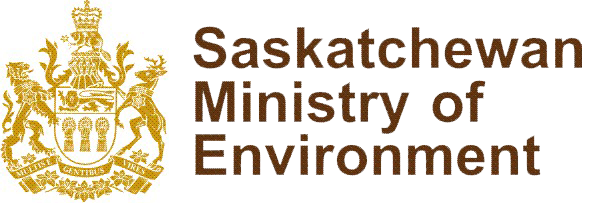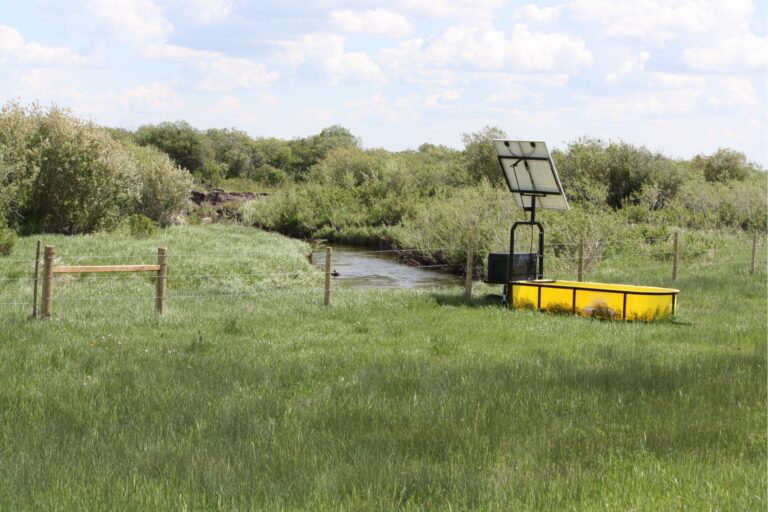by Alexis DeCorby
Ministry of Environment
Dry conditions in much of the province are raising concerns with pasture supply. It’s not too late to put a plan in place. Although supplementing is an additional cost and may require extra labour, it can benefit your operation in the long run.
Supplementing protein is necessary when grass becomes dry and dormant or when there is a lack of moisture that prevents pasture growth. Adequate protein levels allow cattle to efficiently digest the available forage and may also increase dry matter intake.
Internally, cattle have a hierarchy of nutrition requirements. This means that when there are not enough nutrients in feed, cattle will first prioritize maintaining weight followed by lactation and then rebreeding. Cattle that do not receive adequate nutrients from the pasture provided will not reach maximum productivity. A common result of underfeeding protein and energy is open cows in the fall and reduced weaning weights in calves due to reduced milk quality. The potential of lost income may outweigh the additional costs of a supplement.
In some cases, there is a fine line between supplementing and over supplementing. The best way to determine if supplementing is necessary is to monitor body condition. Cows at a healthy condition should be a three on a five-point body condition scale. If cows begin to fall below this condition, it’s time to consider providing a supplement.
Supplements do not always have to be provided daily. If you turn out in early spring, you may be able to put enough bales out for three or four days. If feeding hay isn’t an option, protein lick tubs, pellets or grain are alternative options. Depending on how protein-deficient the pasture is, feeding may only be required every other day. Research has shown that providing more than the daily requirement of protein will allow for stockpiling, meaning the cow will use it later. This saves time and can reduce labour costs. As always, if cattle are not used to consuming concentrates, provide them gradually over time to avoid digestive upsets.
When feeding a protein supplement, do not forget to add mineral and salt. Minerals are vital for rebreeding, milk production and overall maintenance. Mineral and salt should always be available and placed near common loafing areas for maximum consumption.
An additional summer supplementation option is creep feeding calves. If milk production is reduced due to forage production, creep feeding can help alleviate some of the nutritional demands on the cow. Milk production peaks two months after calving, so nutrient demands also peak. At this point, the cows are typically in a net energy deficient state. Ensuring that nutrients are available to the cow and calf during this time is extremely important to maximize calf growth and maintain cow condition.
While creep feeding all summer is an option, it is most valuable when supply and quality are low. Calves will substitute creep feed for forage, which can reduce pasture demand. Reducing pasture demand from calves can help maintain pasture condition.
Creep feeding rations for calves should be formulated based on the situation. If forage quantity is the concern, a 13 per cent protein supplement would be appropriate. If quality is the concern, a 16 per cent protein supplement would be recommended. Keep in mind that calves will also require 65 to 70 per cent total digestible nutrients and an appropriate mineral program to meet their nutritional requirements.
In addition, creep feeding also gets calves accustomed to dry feed, which can also allow for early weaning to take pressure off the cow and the pasture. Calves should gain 0.8 to 1.2 kg per day (1.75 to 2.75 lbs) from birth to weaning. Once adjusted to dry feed, calves can be switched to a ration that will maintain this growth after weaning.
Supplementing cows and calves can help cattle maintain condition, prepare your calves for early weaning and stretch your forage supplies. For more information on this topic or any other livestock-related questions, please contact your local livestock and feed extension specialist or call the Agriculture Knowledge Centre at 1-866-457-2377.
News articles and stories submitted by the Saskatchewan Ministry of Environment.
LATEST ARTICLES
Supplementing protein over the summer
Riparian area management for ecosystem services
by Hillary Luchinski
Saskatchewan Ministry of Environment
Riparian areas are the ‘Green Zone’ of our landscape – the transition zone between our waterbodies or courses and their surrounding uplands. These areas have unique vegetation and soils, which means they provide unique ecosystem goods and services, which are the environmental benefits that people receive from the functions of a properly managed and healthy ecosystem. These include, but are not limited to, climate regulation, water treatment and supply, pollination, nutrient cycling, air quality, carbon sequestration and disturbance regulation. Healthy riparian areas play an especially important role when it comes to plant and animal biodiversity, maintaining and improving water quality and quantity and resilience to changing weather patterns.
For example, almost all of our Saskatchewan wildlife relies on riparian areas at some point in their life cycle. Whether those areas offer shelter, food or a place to raise their young, healthy riparian areas support biodiversity and are especially important for our native pollinators and species at risk. Pollination and biodiversity are ecosystem services.
Similarly, riparian areas play a key role on the landscape when it comes to maintaining the quality and quantity of our freshwater resources. A riparian area with healthy desired vegetation filters pollutants and sediment from overland runoff, holds our shorelines from eroding away and captures nutrients and sediments flowing downstream. That vegetation also plays a huge role in the process of groundwater cycles, recharging our underground aquifers.
Perhaps the biggest benefit of healthy riparian areas is adding resiliency to our landscape in the face of extreme weather events, such as droughts or flooding. Riparian areas and their associated water features provide natural flood control. During wet times, riparian areas slow down the water, allowing it to filter down and store in our aquifers. This reduces downstream damage from flooding and provides an underground water source for the surrounding plants and animals during drier times, or later in the season.
What can you do to help maintain riparian areas?
- Manage livestock access with exclusion fencing, remote watering systems, graded access ramps or deferred grazing to when riparian areas are less sensitive;
- Leave a minimum 30 metre vegetated buffer between cropland and water features; and
- Manage invasive species in riparian areas to maintain desired native vegetation.
For more information on riparian area management or programs to manage livestock access to riparian areas, call the Agriculture Knowledge Centre at 1 (866) 457-2377.


